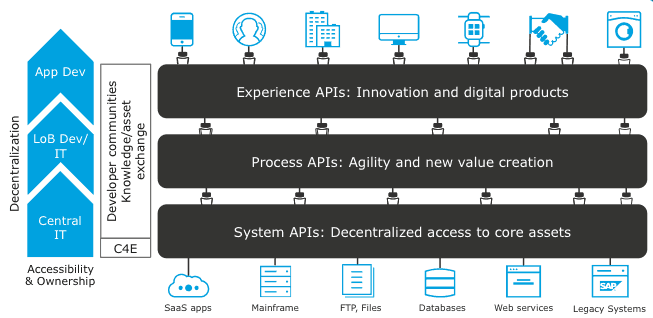You don’t need us to tell you how drastically the retail industry is changing. The convergence of channels driven by always-connected consumers and emerging technology is completely altering the way we shop for everything. To keep up with the pace of change, retailers need to be agile, flexible, and adaptable, which isn’t always easy with B2B technology standards. Here are the top 4 B2B challenges that retailers have to solve in order to thrive amidst digital disruption.
The top 4 B2B challenges for retailers
What are the main challenges that retailers are facing? They all have to do with speed and agility — how quickly they can adapt to change.
1) Responding to consumer trends
Consumers want more high-quality goods at a lower price delivered quickly across multiple channels. That’s not too much to ask, is it? Shoppers are focused on price and convenience no matter where they shop, whether it’s in-store or online — or some combination of both. However, there is a disconnect between what shoppers expect of a modern omnichannel retailer and what they often get. Providing the shopper what they want when they want it requires a streamlined, connected supply chain which can provide the development, sourcing, and production of seasonal and in-demand products just-in-time to service multiple markets and channels.
2) Reducing Operational Inefficiency
Every retailer wants to maintain an efficient operation, which means that managing complexity and change is a necessity. But it’s quite difficult to do. Organizational silos hamper communication, consistency, and collaboration across the business, and the dependency on manual operations, particularly in B2B transactions, are often cumbersome. Believe it or not, according to a supply chain benchmark study from Boston Retail Partners, 46% of North American retailers are using spreadsheets to manage their supply chain planning. This isn’t just inefficient; it can actually create costs.
3) Staying ahead of slipping profit margins
Anything that creates extra work and inefficiency affects the retailer’s bottom line — profit. We know customers are price-sensitive, the global economy is still on shaky ground, and consumer shopping patterns are changing.
Retailers are turning to technology to help them shore up declining profit margins. In an IDC Retail Insights Survey, “improving profit margins” was listed as a top objective driving IT investment.
4) Implementing omnichannel integration
Multiple selling channels are expanding, and quickly. These days, consumers use at least three channels when shopping, spend more, generate more profit, and are much more loyal. In order for multi-channel shopping to be a satisfying experience for consumers, retailers must offer a consistent product offering, price, and customer experience across all of their channels. Therefore, retailers have to align organizational objectives, streamline and improve their business processes, make order and inventory management more seamless, and deliver information to consumers in a timely and relevant fashion.
Is there a single solution to these challenges?
To achieve many of the objectives outlined above, retailers rely on B2B communication. And a global standard for B2B communication in retail is the notoriously cumbersome EDI. Over time, EDI message standards have become frayed such that the vision of a consistent, industry-wide message standard providing economies of scale and scope in B2B interactions, has become significantly diluted.
EDI messages are verbose and reflect a previous age where B2B/EDI transactions were traditionally processed in batches, rather than the real-time processing and processing transparency that today’s trading landscape demands. B2B systems that transmit EDI messages are integrated into a point-to-point system, rather than a platform, increasing fragility and complexity, and creating yet more demands on central IT to maintain.
When EDI first came into use, supply chains were simpler, with a limited number of suppliers. Now, thanks to globalization and specialized manufacturing, there might be hundreds of suppliers in a supply chain, which, as market conditions evolve, may change as well. Businesses want control and visibility over their processes, even as they grow more complex, because they are so integral to business strategy and success.
Yet EDI isn’t going away anytime soon. To succeed, companies must find a way to marry new architectural approaches to B2B/EDI challenges that insulate the legacy technologies from the new and abstract its limitations.
MuleSoft’s work with retail leaders suggests that it is possible to solve the challenges outlined above, despite the constraints that B2B/EDI can impose. These organizations are applying API and microservices approaches to drive innovation approach that supports innovation while utilizing B2B/EDI technologies.
Modernizing B2B/EDI through API-led connectivity
API-led connectivity is a multi-layered approach that scales IT capacity through by emphasizing modular components, decentralized authority over application development, and reusable assets. It is a different IT operating model; it promotes decentralized access to data and capabilities while retaining security.
API-led connectivity calls three-layered architecture with the following components:
- System Layer: Underlying all IT architectures are core systems of record (e.g. one’s ERP, key customer and billing systems, proprietary databases etc). Often these systems are not easily accessible due to connectivity concerns; APIs conceal that complexity from the user. System APIs provide a means of accessing underlying systems of record and exposing that data, often in a canonical format, while providing downstream insulation from any interface changes or rationalization of those systems. These APIs will also change more infrequently and often will be governed by central IT given the importance of the underlying systems.
- Process Layer: The business processes that interact with and shape this data should be encapsulated independently of the source systems where the data originates, as well as from the target channels through which data is to be delivered. For example, in a purchase order process, there is some logic that is common across products, geographies, and retail channels that can and should be distilled into a single service that can then be called by other services.
- Experience Layer: Data is now consumed across a broad set of channels, each of which want access to the same data but in a variety of different forms. For example, a retail branch POS system, e-commerce site, and mobile shopping application may all want to access the same customer information fields, but each will require that information in very different formats. Experience APIs reconfigure data so that it is most easily consumed by its intended audience all from a common data source, as opposed to setting up separate point-to-point integrations for each channel.
In the EDI context, an API-led connectivity approach provides both flexibility to serve different partners, but tight control over core ERP systems:
- Experience API layer: Different experience APIs by channel, perhaps e-commerce, or SaaS application, or data interface
- Orchestration API layer: Different process APIs by business process e.g. executing a purchase order, checking inventory level
- Data Access API layer: Different data access APIs to wrap key systems of record
The architectural benefits of this approach are a decoupled architecture that abstracts away complexity, and a more agile response to change. All of your channels are able to reuse the same process logic, so as you on-board new partners, you only need to manage the logic of receiving messages and the purchase order processing logic is already baked in, thus allowing greater speed.
Case study: Engaging customers in new ways and new markets
One retailer in North America has a business model of bricks and mortar stores that show goods that you can rent instead of purchase. You pay a monthly fee to lease sofas, TVs, desks, etc. They have realized that revenue growth potential is limited by the number of bricks and mortar stores they have, so they decided to enter into a number of different partnerships with other retailers to install digital kiosks or booths in those retailers and allow those retailers to also benefit from the company’s services, albeit through the digital kiosk.
They are able to build an end-to-end supply chain process from customers buying things in the kiosks, to actual purchase orders being generated on the back end. This is an example of a business being extended by B2B/EDI functionality and engaging their customers in new and interesting ways.
Interested in more?
MuleSoft has numerous resources for retailers taking on digital transformation initiatives. Take a look at more information on modernizing your supply chain, taking on omnichannel initiatives, and connecting silos in your organization.










